 As UHN's monthly research newsletter, NRx reports on the full spectrum of leading research from UHN's five research institutes: the Princess Margaret (PM) Cancer Centre, the Toronto General Research Institute (TGRI), the Toronto Western Research Institute (TWRI), the Toronto Rehabilitation Institute (TRI) and the Techna Institute (Techna).
As UHN's monthly research newsletter, NRx reports on the full spectrum of leading research from UHN's five research institutes: the Princess Margaret (PM) Cancer Centre, the Toronto General Research Institute (TGRI), the Toronto Western Research Institute (TWRI), the Toronto Rehabilitation Institute (TRI) and the Techna Institute (Techna).
In this issue you can read about:
- How resveratrol and metformin reduce sugar production in the liver
- A new footwear material that provides superior grip on ice
- Evidence that gut immune cells can impact blood sugar levels
- A new way to visualize the brain's response to surgical treatments
- The use of artificial intelligence to help plan radiation treatment
- Three new radiation therapy products co-developed by UHN
- A new partnership to advance therapeutic antibodies
We hope that you will find NRx informative. If you have feedback or questions, please contact www@uhnresearch.ca.
Christopher J. Paige, PhD, FCAHS
Vice President, Research
University Health Network
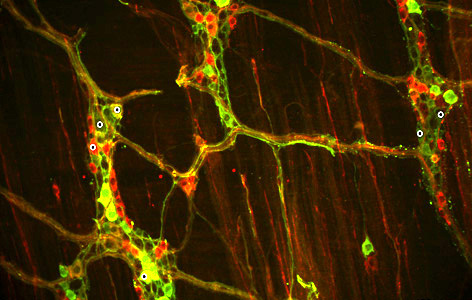
The gut has its own network of nerves, called the enteric nervous system (pictured as a fluorescence image with neurons stained green and red) that transmit signals to the brain.
Diabetes is characterized by elevated blood sugar levels, due in part to the increased production of sugar by the liver. Drugs that interfere with the liver's ability to produce sugar are therefore promising treatments for the disease. Two such compounds are metformin (the most widely prescribed drug for type 2 diabetes) and resveratrol (an antioxidant found in red wine); however, it is not clear exactly how these compounds work to lower sugar production in the liver.
Two studies by TGRI Senior Scientist Dr. Tony Lam and his team provide new insight into the ways in which metformin and resveratrol control diabetes. The studies, published back-to-back in Nature Medicine, used experimental diabetic and obese models to demonstrate that the compounds activate sensing molecules in the gut. Once activated, the molecules trigger the gut nervous system to relay signals to the liver via a neuronal network to stop producing sugars.
"Knowing the signals used by these organs to interact with each other will help us to design drugs that target the gut, which is a previously underappreciated avenue for the development of new diabetes therapies," explains Dr. Lam. "Because such drugs act locally, they may have less side effects."
These works were supported by the Canadian Institutes of Health Research. TK Lam holds a Tier 2 Canada Research Chair in Obesity, and is the John Kitson McIvor Endowed Chair in Diabetes Research & Canada Research Chair in Obesity. Image modified from "Mazzuoli et al. Mechanosensitive enteric neurons in the myenteric plexus of the mouse intestine. (2012) PLoS ONE 7(7):e39887".
Metformin activates a duodenal Ampk-dependent pathway to lower hepatic glucose production in rats. Duca FA, Côté CD, Rasmussen BA, Zadeh-Tahmasebi M, Rutter GA, Filippi BM, Lam TK. Nature Medicine. 2015 Apr 6. [Pubmed abstract]
Resveratrol activates duodenal Sirt1 to reverse insulin resistance in rats through a neuronal network. Côté CD, Rasmussen BA, Duca FA, Zadeh-Tahmasebi M, Baur JA, Daljeet M, Breen DM, Filippi BM, Lam TK. Nature Medicine. 2015 Apr 6.[Pubmed abstract]
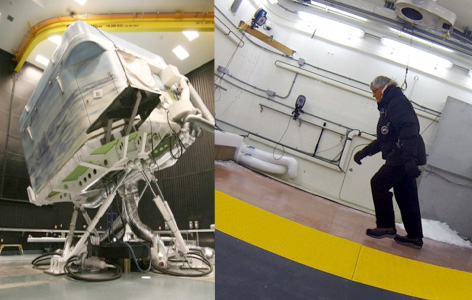
TRI has advanced facilities to test the performance of winter footwear, including WinterLab, which can tilt an ice-covered floor.
Annually, over 21,000 Ontarians end up in emergency rooms because of slips on ice or snow and many avoid going outside for fear of falling. To address this serious issue, TRI researchers, including Research Associate Dr. Yue Li, Postdoctoral Fellow Dr. Reza Rizvi and Scientist Dr. Tilak Dutta, are investigating new materials to improve winter boot traction, and advanced ways of evaluating the performance of winter footwear.
Ice is a challenging surface to grip because a quasi-liquid layer of water acts as a lubricant between the ice and a walker's boot. Ice cleats grip ice by penetrating through this liquid-like layer into the solid ice below—but this approach does not work on hard indoor surfaces, and cleated footwear can lead to falls when returning indoors.
Using a novel manufacturing technique, the research team developed a composite, rubber-like material with microscopic glass fibres that protrude from the surface. These fibres act like 'micro-cleats' to penetrate the liquid layer, providing four times more traction on ice than molded rubber. "This material is still a long way from being used in commercial footwear. One issue is that we need to make it harder so it will last longer," says Dr. Dutta.
"We use a facility called WinterLab to objectively test footwear performance on real ice. In Winterlab, participants walk up and down ice-covered slopes that can be made steeper. As well as helping to develop better footwear materials, WinterLab enables objective slip-resistance ratings to be defined so that consumers can be better informed before making a purchase." To see videos of their footwear testing process, visit the TRI Technology Team website.
This work was supported by the Technology Evaluation in the Elderly Network (part of the Networks of Centres of Excellence), the Canada Foundation for Innovation, the Natural Sciences and Engineering Research Council, the Government of Ontario and the Toronto Rehab Foundation. H Naguib holds a Tier 2 Canada Research Chair in Smart and Functional Polymers. Image credit: Dr. Tilak Dutta.
High friction on ice provided by elastomeric fiber composites with textured surfaces. Rizvi R, Naguib H, Fernie G, Dutta T. Applied Physics Letters. 2015 Mar 16. [Pubmed abstract]

One in four Canadian adults and one in ten Canadian children are living with obesity.
The hormone insulin helps to maintain healthy blood sugar levels. In type 2 diabetes, the body no longer responds to insulin, leading to a spike in blood sugar levels, which can damage organs, blood vessels and nerves. People who are obese are more likely to have high blood sugar levels and develop type 2 diabetes; however, the molecular mechanisms underlying this predisposition are not well understood.
A recent study by TGRI Scientist Dr. Daniel Winer suggests that obesity contributes to high blood sugar levels by altering the immune system in the gut.
Using an experimental model, the research team demonstrated that obesity leads to activation of the immune cells residing in the intestine. The researchers then explored whether there might be a link between these activated immune cells and diabetes. By disabling these immune cells, they were able to lower blood sugar levels and restore insulin sensitivity. Moreover, researchers found that 5-aminosalicyclic acid, a drug that dampens the immune response, reduced the number of activated immune cells in the intestine and improved blood sugar levels.
"These results are novel and important because we have identified the immune system in the gut as a new player in the control of blood sugar and a new therapeutic target for type 2 diabetes." says Dr. Winer.
This work was supported by the Canadian Institutes of Health Research, the Canadian Diabetes Association, the University of Toronto and the Toronto General & Western Hospital Foundation. TK Lam holds a Tier 2 Canada Research Chair (CRC) in Obesity. M Woo holds a Tier 2 CRC in Signal Transduction in Diabetes Pathogenesis. SE Girardin holds a Tier 2 CRC in Innate Immunity and Microbial Pathogenesis.
Regulation of obesity-related insulin resistance with gut anti-inflammatory agents. Luck H, Tsai S, Chung J, Clemente-Casares X, Ghazarian M, Revelo XS, Lei H, Luk CT, Shi SY, Surendra A, Copeland JK, Ahn J, Prescott D, Rasmussen BA, Chng MH, Engleman EG, Girardin SE, Lam TK, Croitoru K, Dunn S, Philpott DJ, Guttman DS, Woo M, Winer S, Winer DA. Cell Metabolism. 2015 Apr 7. [Pubmed abstract]

Trigeminal neuralgia causes excruciating facial pain that often occurs spontaneously and seemingly without any cause.
Patients with classical trigeminal neuralgia (TN) experience intense, electric shock-like facial pain. These symptoms can last anywhere from several seconds to a few minutes and often recur multiple times throughout the day. The pain is caused when a nerve that carries information about sensation in the face, known as the trigeminal nerve, either starts to malfunction or is compressed by a blood vessel. With time, the intensity and frequency of these attacks increases and patients become less responsive to medication.
Some relief can be provided by neurosurgical treatments, which either aim to move blood vessels away from the trigeminal nerve, or reduce the sensitivity of the nerve. However, the effects of these surgical procedures on the brain are still poorly understood, which makes it difficult to understand the mechanisms underlying a patient's response to treatment.
A recent study, led by TWRI researchers Drs. Mojgan Hodaie and Karen Davis along with their PhD student Danielle DeSouza, used a noninvasive magnetic resonance imaging technique to quantify the gray matter in the brain and diffusion tensor imaging (DTI) to quantify structural changes that occur in the trigeminal nerve of TN patients before and after neurosurgery. They found that TN patients had abnormalities in their trigeminal nerve and in the gray matter of widespread regions of the brain. They also discovered that these brain abnormalities were significantly reversed following surgery. Moreover, the reversal of the trigeminal nerve abnormalities was correlated to the level of pain relief that patients experienced after the treatment.
Explains Dr. Hodaie, "This is the first study to show that DTI can be used to measure the effectiveness of neurosurgical pain treatments. By adding this technique to conventional imaging methods we will now be able to assess and customize treatment plans for patients."
This work was supported by the Canadian Institutes of Health Research, the Physicians' Services Incorporated Foundation, the University of Toronto and the Toronto General & Western Hospital Foundation.
Reversal of insular and microstructural nerve abnormalities following effective surgical treatment for trigeminal neuralgia. DeSouza DD, Davis KD, Hodaie M. Pain. 2015 Mar 9. [Pubmed abstract]
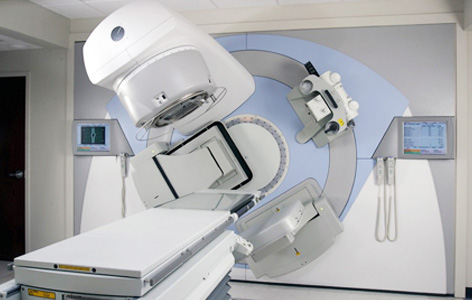
High-precision dosages of radiation provided by an IMRT machine (pictured) match the three-dimensional shape of a tumour and reduce treatment side effects.
When administering radiation therapy, specialists must create a treatment plan that ensures that the tumour is targeted, while healthy tissue is spared.
When tumours are located close to organs that are susceptible to radiation damage, such as the brain or lungs, a complex form of radiotherapy known as intensity modulated radiotherapy (IMRT) is used. In IMRT, the size and intensity of multiple beams of radiation are varied to better target the tumour. The drawback to IMRT is that it can take up to several hours to create treatment plans.
Dr. Thomas Purdie (PM Cancer Centre Clinical Researcher and Techna Affiliated Faculty) devised a solution to this problem by taking advantage of the latest advancements in machine learning.
Machine learning involves using existing information to create a model that can then make informed decisions in new situations. In this case, Dr. Purdie's team used 149 previously approved clinical treatment plans to create a model capable of predicting clinically acceptable angles for radiation beams. The computational tool was then tested on 27 new treatment scenarios.
Dr. Purdie explains, "The beam selection process only took a few minutes to complete using the method developed. Furthermore, over ninety percent of the plans were approved as clinically acceptable by three experts. The refinement and widespread use of this method could help conserve human resources while ensuring treatment consistency."
This work was supported by Philips Healthcare, the Ontario Consortium for Adaptive Interventions in Radiation Oncology, the Collaborative Health Research Projects Program, the Canadian Institutes of Health Research, the Natural Sciences and Engineering Research Council of Canada, and The Princess Margaret Cancer Foundation.
Automatic learning-based beam angle selection for thoracic IMRT. Amit G, Purdie TG, Levinshtein A, Hope AJ, Lindsay P, Marshall A, Jaffray DA, Pekar V. Medical Physics. 2015 Apr. [Pubmed abstract]
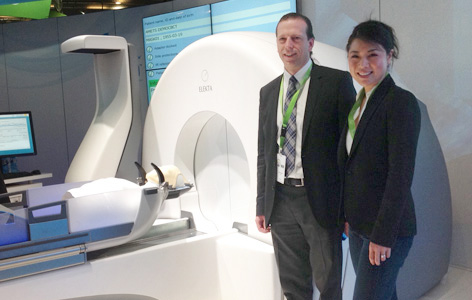
Princess Margaret's Drs. David Jaffray and Caroline Chung in front of Elekta's Icon system at the launch event in Barcelona.
Three technologies developed at Princess Margaret, matured through Techna and commercialized by UHN's Technology Development and Commercialization (TDC) Office were launched as products this month at the European Society for Radiotherapy & Oncology (ESTRO) Forum in Barcelona, Spain.
The first of these products, known as the Integral Quality Monitor (IQM), was invented at UHN and commercialized by the German start-up iRT. IQM enables radiation therapy specialists to monitor therapy while a patient is being treated and serves as a "final check" while the radiation is administered to further improve safety. The technology is currently being beta tested at 20 sites around the world and was officially revealed to the public for the first time at ESTRO.
The second technology that was unveiled is a next-generation radiosurgery platform, known as the Leksell Gamma Knife® Icon™. The technology incorporates cone-beam CT image-guidance capabilities that were developed and prototyped at UHN, and was launched by Elekta—a leading multinational manufacturer of radiotherapy devices. "The imaging system unlocks new and exciting capabilities for the Gamma Knife," explains Techna Director Dr. David Jaffray.
The third, called AQUA, is an end-to-end software platform for managing department-level quality assurance and scheduling, which will help improve workflows and safety in radiation therapy departments. AQUA is being commercialized by Acumyn, an Ontario corporation spun off to commercialize and productize the platform. Sales and marketing of AQUA will be handled by Elekta through an exclusive agreement.
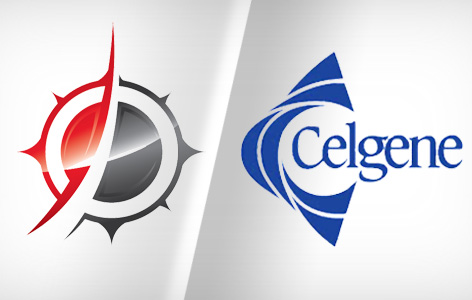
Northern Biologics (logo on the left) and Celgene announced a collaboration to develop antibody therapies.
Northern Biologics is a privately held company that was developed at UHN and UT. It was recently announced that the start-up company, which is commercializing antibody therapeutics, has entered into a strategic collaboration with Celgene Corp., a multinational biopharmaceutical company headquartered in New Jersey.
The deal includes a $30M upfront cash payment to Northern Biologics, which will help fund the discovery and development of first-in-class therapeutic antibodies for oncology and fibrosis.
In exchange for helping to advance Northern Biologics' technology, Celgene will have options to license the work and the right to acquire Northern Biologics upon the conclusion of the collaboration. PM Cancer Centre Senior Scientist and Interim Director Dr. Bradly Wouters comments, "Celgene's investment will accelerate the development of targeted biologics for personalized cancer medicine. This support reflects both the commercialization opportunities that derive from direct investments in basic research as well as the synergy within the founding team of scientists."
 Techna Affiliated Faculty and PM Cancer Centre Clinical Researcher Dr.
Techna Affiliated Faculty and PM Cancer Centre Clinical Researcher Dr.  PM Cancer Centre Senior Scientist Dr.
PM Cancer Centre Senior Scientist Dr.  UHN is proud to announce the renewal of Canada Research Chairs for Drs.
UHN is proud to announce the renewal of Canada Research Chairs for Drs.  TWRI Senior Scientist Dr. Elise Stanley was inducted into Johns Hopkins University Society of Scholars at a ceremony hosted by the Provost, Robert C. Lieberman. The honour was bestowed to Dr. Stanley, along with 15 other inductees, on April 13th, 2015 in Baltimore.
TWRI Senior Scientist Dr. Elise Stanley was inducted into Johns Hopkins University Society of Scholars at a ceremony hosted by the Provost, Robert C. Lieberman. The honour was bestowed to Dr. Stanley, along with 15 other inductees, on April 13th, 2015 in Baltimore.